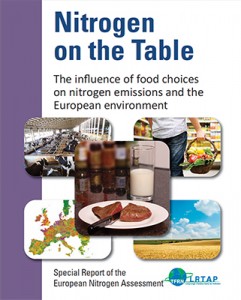 Nitrogen is a basic component of our food and a vital nutrient for plants and crops to grow. But high concentrations are harmful to people and nature. Last week, the presentation of a scientific report in the European Parliament, “Nitrogen on the Table”, tried to call attention to this problem. In this report, the authors considered the major benefits of reduced meat and dairy consumption in Europe, since so far more focus has been put on the supply side, developing technological solutions. And I fully agree; we need to reduce European consumption of meat and dairy, and we need to look beyond those “miraculous” technological solutions.
Nitrogen is a basic component of our food and a vital nutrient for plants and crops to grow. But high concentrations are harmful to people and nature. Last week, the presentation of a scientific report in the European Parliament, “Nitrogen on the Table”, tried to call attention to this problem. In this report, the authors considered the major benefits of reduced meat and dairy consumption in Europe, since so far more focus has been put on the supply side, developing technological solutions. And I fully agree; we need to reduce European consumption of meat and dairy, and we need to look beyond those “miraculous” technological solutions.
But I always have some concerns when the political debate focuses too much on individual solutions, like reducing meat consumption. For me, that means we are missing one key question: Who is really causing the mess?
According to the study, the mess is being caused by industrial agriculture, responsible of around the 80 percent of nitrogen emissions in the EU. More specifically, livestock production accounts for between 81 and 87 percent of that amount. Obviously, when talking about pollution caused by livestock, it is not fair to mix small and medium scale farms raising livestock in the countryside with factory farms that confine thousands of cows, pigs and chickens in tightly packed facilities.
The European Commission, when assessing nitrogen pollution, admits that “large numbers [of animals] concentrated locally or regionally pose high risks to the environment as manure production is out of balance with land availability and crop needs. This imbalance creates a surplus of nutrients, much of which is sooner or later lost to water (nitrates and phosphates) and air (ammonia and nitrogen oxides), if not exported out of the region.”
High nitrate concentrations in drinking water are considered a risk to human health. In surface waters and coastal zones nitrogen causes eutrophication, which leads to biodiversity loss, algae blooms and fish kills. Emissions of ammonia lead to loss of terrestrial biodiversity, while nitrous oxide is a powerful greenhouse gas.
Nitrate pollution is not a new problem. The European Union already approved the Nitrates Directive in 1991 to protect water quality across Europe by addressing nitrate pollution from agricultural sources.
Although water quality has improved since, the problem is extremely far from solved. Member states need to designate vulnerable zones according to the directive, and implement in those areas action programs to prevent and reduce water pollution by nitrates. The total area to which those action programs apply corresponds to about 46,7 percent of the total EU land area. We are facing a huge problem.
Are governments really addressing the situation? As of June 2013, ten infringement cases were opened against eight member states that were not complying with the Nitrates Directive, including France, Luxembourg, Greece, Poland, Slovakia, Bulgaria, Italy and Latvia. Other cases related to the directive were opened against Spain, UK, Belgium or Italy.
Our sister organization Food & Water Watch is working hard to unmask the culprits in the United States and stop the “Factory Farm Nation.” They are also working to raise awareness about the problems with water pollution trading – a market-based approach to controlling pollution from factory farms that actually undermines existing regulations. Here in Europe, years of misguided agricultural policies, constant deregulation, free trade agreements and uncontrolled agribusiness power have fuelled a model of factory farming that we urgently need to tackle. That’s why we will be working hard against factory farm in the coming months. Stay tuned!


